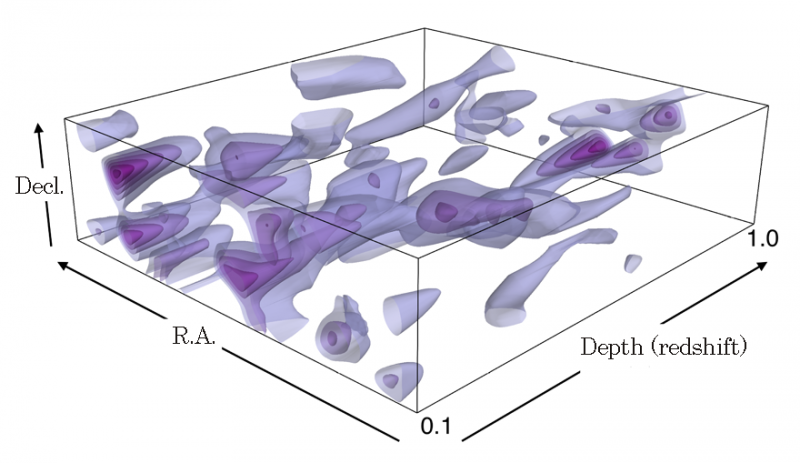March 2, 2018
Kavli Institute for the Physics and Mathematics of the Universe (Kavli IPMU)

The first two years of data from an international team mapping the Universe has progressed research in several areas of astronomy and physics, including the search for new objects in the solar system, studies about galaxies, and dark matter, it has been reported in the latest issue of the Publications of the Astronomical Society of Japan (PASJ) (Figure 1).
An international team including National Astronomical Observatory of Japan (NAOJ), Kavli Institute for the Physics and Mathematics of the Universe (Kavli IPMU) at the University of Tokyo, Academia Sinica Institute for Astronomy and Astrophysics (ASIAA, Taiwan), and Princeton University, has been conducting a large-scale astronomical survey using the Hyper Suprime-Cam (HSC), an ultra-wide-field camera installed at the prime focus of the Subaru telescope in Hawaii since 2014.
This large-scale survey, HSC-SSP (Hyper Suprime-Cam Subaru Strategic Program), takes advantage of the HSC’s ability to capture a large area of the sky, equivalent to nine times the area of a full moon, and will attempt to address the mystery of the accelerating expansion of the Universe by mapping the global distribution of dark matter with unprecedented resolution. The survey is expected to continue until 2019.
One of the major results so far is the creation of a two-dimensional and three-dimensional dark matter map over an unprecedented area with an unprecedented resolution, which was led by University of Tokyo School of Science Assistant Professor and Kavli IPMU Associate Scientist Masamune Oguri. It is based on the HSC data accumulated by April 2016 (11 per cent of the overall data size planned), and built by analyzing gravitational lensing effects captured by the telescope.

Figure 2 shows the dark matter distribution over the area of about one billion light years, times 250 million light years, and over the depth of eight billion light years. This is the first time a three-dimensional map over such a large volume has been built, which was made possible thanks to the high light-collecting power of the Subaru telescope.
Moreover, the team found that the simplest and current standard model of the accelerating Universe might not be able to account for the clumps of dark matter in this map.
The team expects to understand the fate of the Universe, evolution of the structure in the Universe over time, and time variation of the amount of dark energy, using the three-dimensional map of dark matter and analyzing more HSC-SSP data in the future.
More details of the results can be found in the press release from NAOJ.
Kavli IPMU Principal Investigator Masahiro Takada, who currently serves as the co-chair of the HSC-SSP science working group, made the following comment on this occasion of publishing initial results.
“We can create a huge map of the Universe at an incredible speed using the large aperture and wide field of Subaru HSC. We can discover many faint and rare astronomical objects and phenomena using this map. We already discovered objects at the outer edge of the solar system, very faint and tiny galaxies in the neighborhood of our Milky Way Galaxy, clusters of galaxies 8 billion light years away, and quasars of thirteen billion years ago. We could also build a map of dark matter utilizing the gravitational lensing effects measured by employing cutting-edge data analysis technique that quantifies galaxy shapes precisely. More than 200 scientists have been involved and we could publish many results based on the team effort. Our team is working hard to produce even more exciting results.”
Kavli IPMU Director Hitoshi Murayama’s comment.
“This HSC-SSP project is about conducting a ‘cosmic census’ to decipher the evolution and fate of the Universe. This kind of research is new to the study of the Universe in Japan, but also is receiving a lot of attention from the international community. Kavli IPMU contributed about a half of the instrument, including the design and construction of the special system of lenses and the system of precision mechanical control. The results published this time are already world class, but we anticipate surprising discoveries with the six-fold data sets expected by the end of the project.
We are now working on the spectroscopic follow-up on the HSC data using a new instrument called Prime Focus Spectrograph (PFS). We are sure that Subaru will be running at the forefront for the next twenty years in the world.”
Related Links:
SPECIAL ISSUE: SUBARU HYPER SUPRIME-CAM SURVEY (Journal)
Unprecedentedly Wide and Sharp Dark Matter Map (Subaru Telescope website)
Early Science Results from the Hyper Suprime-Cam Survey (Subaru Telescope website)






